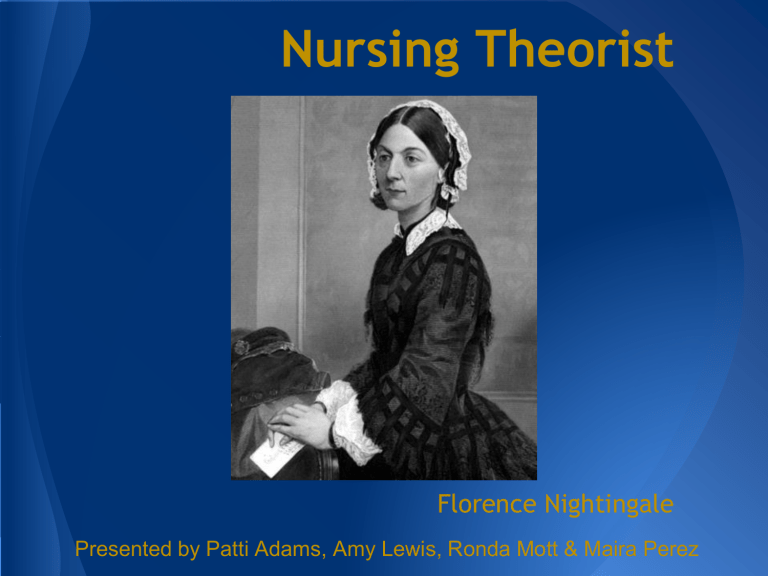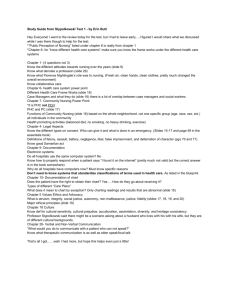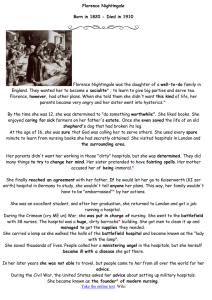Nursing Theorist - Patricia M Adams RN, CDN

Nursing Theorist
Florence Nightingale
Presented by Patti Adams, Amy Lewis, Ronda Mott & Maira Perez
Nursing
One Woman. One Calling. One Mission.
Introduction
Florence Nightingale's nursing theory can be considered a 'descriptive theory', by providing nurses a way to think about patients and their environment.
Florence Nightingale's theory was the initial model for nursing and was focused on manipulating the client's environment to improve their health. She based her theory on health maintenance and restoration. Her spiritual philosophy prompted her nursing views.
Assumptions and Point of View
Florence Nightingale's theory was the initial model for nursing. She collected
•
•
•
•
•
• data and observed clients, linking their health status to factors in the environment.
Nursing practice was influenced by her belief in the provision of fresh air, light, warmth, cleanliness, quiet, and adequate nutrition
Defined differences between nursing and the practice of medicine
Encouraged nurses to act on behalf of the client
Pioneer in nursing in the Crimean War, 1853
Initiated major reforms in hygiene, sanitation and nursing practice
Assisted with decreasing mortality rate in Turkish hospital from 42.7% to
•
2.2% by improving the quality of the sanitation facilities
Established St. Thomas's Hospital in London in 1960
(Bloy, 2012)
Information and Concepts
Human Beings
Environment
Health
Nursing
Interpretation, Influence,
Implications & Consequences
•
Shaped nursing
•
Notes on Nursing: What It Is and What It
Is Not
•
Nursing education model for the United
States
•
Basis of several nursing theories
Evaluation of the Nursing Model
•
Nightingale is unique to nursing
•
Her work represents the beginning of professional nursing.
•
She set forth principles that remain relevant to nursing practice today.
•
Her model was influenced by her passion to serve others.
Does this model adequately describe the four global concepts?
•
Human: The patient is the focus
•
Environment: Providing clean air, water, proper ventilation, and sunlight.
•
Health: Positive changes in health.
•
Nursing: She set the foundation in nursing and remains relevant today.
E
N
C
E
F
L
O
R
T
I
N
G
A
N
I
G
H
L
E
Other Theories Generated From or
Influenced by Nightingale's Holistic
Concept
1.
Roy's Adaptation Model
2. Levine's Conservation Theory
3. Modeling and Role Modeling Theory
4. Watson's Theory of Transpersonal Caring
Roy's Adaptation Model
•
Adaptation -- goal of nursing
•
Person -- adaptive system
•
Environment -- stimuli
•
Health -- outcome of adaptation
•
Nursing-- promoting adaptation and health
(Chitty & Black, 2011 )
Levine's Conservation
Theory
•
•
•
Adaptation
Wholeness
Conservation
(Levine, 1973)
Modeling and Role Modeling
Theory
This theory draws concepts from:
•
•
•
Maslow's theory of hierarchy of needs
Erikson's theory of psychosocial stages
Piaget's theory of cognitive development
According to the theory the roles of nursing are:
•
•
•
Facilitation
Nurturance
Unconditional Acceptance
(Sappinton, 1996 June)
Watson's Theory of Transpersonal Caring
•
Indicates that Nightingale's blueprint for transpersonal meanings and models of caring transcend history.
•
It called forth the full use of self, connecting the divine within and without as a source of inspiration as well as the foundation for a professional code.
(Watson, 1998)
The reviewed theories differ in environmental influences and other aspects of nursing but share holistic concepts.
Examples
Wash in wash out
Florence Nightingale's belief about cleanliness remains important in healthcare today for the purpose of limiting the spread of resistant organisms. "Wash In, Wash Out". We now use isolation precautions to attempt to block the spread of organisms, and also to protect the patients from the introduction of harmful organisms while they are in a compromised state.
Rest
Encouraging rest, so the body can heal and better deal with the stress of being in an altered state of health, was also a belief of Florence Nightingale. In the ICU's at
Spectrum Health, we have a two hour block of time each afternoon when we limit noise, turn down the lights and minimize patient care activities when possible.
Examples
Reducing the spread of infection
Nightingale promoted the view that nurses primary responsibility was to protect patients by careful management of their surroundings (Chitty & Black, 2011). In our radiation oncology clinic, upon entering the front doors, patients are directed to a special station to utilize facial masks and hand sanitizer. Nurses help patients and family members decrease the potential of spreading unwanted infectious illnesses.
Clean water
Nightingale promoted clean water. One of the most important parts of dialysis is the water quality. Reverse osmosis systems for water purification are used to reduce the risk of infection and exposure to toxins.
Examples
Providing a positive environment
Nightingale recognized the effect of the environment on the patient's health or recovery(Chitty & Black, 2011). In practice I practice this by having a positive attitude with the patient. Providing natural sunlight, cleanliness, and personalizing their space as they wish.
Promotion of Health and Healing Starts
Here
Conclusion
Florence Nightingale was a leader in the the nursing profession far before her times.
Questions?
Case Study
Mrs. Smith is a patient on a med-surg floor, and has been in the hospital for 11 days. She was admitted with pneumonia, but has since developed a UTI after having a urinary catheter in place for 7 days. She has been on several different antibiotics during this hospitalization, and yesterday was diagnosed with
Clostridium Difficile (C. Diff.) in her stool and has been placed in enteric isolation precautions.
As Mrs. Smith was being placed in isolation precautions yesterday,the nurse discussed with the patient and her family about the new diagnosis of C. Diff., and the need for strict adherence to isolation precautions as well as the rationale behind these precautions. Today you notice some things that need to be addressed with the family and some neighbors who have come to visit. The family continues to bring food from the cafeteria into the patient room (for themselves to eat), they aren't wearing isolation gowns in the room, and they frequently don't wash their hands when leaving the room.
Additionally, Mrs. Smith frequently has verbalized to the nurse about how exhausted she is, and that she is not able to get any rest while "there is a parade of family and friends going in and out of my room". Her daughter and 3 grandchildren have been staying in the hospital room around the clock and have had the TV on quite loud all night long. When the nurse has requested that there be some 'quiet time' for Mrs. Smith so that she may sleep at night, as well as have some naps during the day, she is met with resistance from the family. They have made statements such as "well, Mom has the TV on all the time at home so she should be used to it" and "how else can I keep the grandkids quiet in here if I can't have the
TV on with cartoons for them?"
Case Study Questions
1. Using Florence Nightingale's philosophy, what can you suggest to the family and neighbors that will promote rest? List three.
2. After reading the case study, what portions of Florence
Nightingale's theory could be integrated in the teaching of Mrs. Smith and her family regarding her care during this hospitalization? List three.
Resources and Web Links
Bloy, M. (2012 January). Florence Nightingale (1820-1910). The
Victorian Web . Retrieved June 24, 2013, from http://www.victorianweb.org/history/crimea/florrie.html
Chitty, K. K., & Black, B. P. (2011). Profession nursing:
Concepts and challenges (6 ed.). Maryland Heights, MO:
Saunders Elsvier.
Levine, M. E. (1973). Introduction to clinical nursing.
Philadelphia, PA: F.A. Davis Company.
Potter, P., & Perry, A. (2009). Fundamentals of nursing (7th ed.).
St. Louis, MO: Mosby.
Resources and Web Links
Retrieved from http://www.commons.wikimedia.org/wiki/file:Fl orence_Nigtingale.png
Sappinton, J. K. (1996 June). Modeling and role-modeling theory: A case study of holistic care. Journal of Holistic
Nursing, 14 (2), 130-141.
Selanders, L. C. (2010 March). The power of environmental adaptation: Florence Nightingale's original theory for nursing practice. Journal of Holistic Nursing, 28 (1), 81-88.
Resources and Web Links
Watson, J. (1998). Florence Nightingale and the enduring legacy of transpersonal human caring. Journal of Holistic Nursing,
16 (2), 292-294.
Winklestein, W. (2009). Florence Nightingale: Founder of modern nursing and hospital epidemiolgoy. Epidemiology,
20 (2), 311. doi:10.1097/EDE.0b013e3181935ad6




